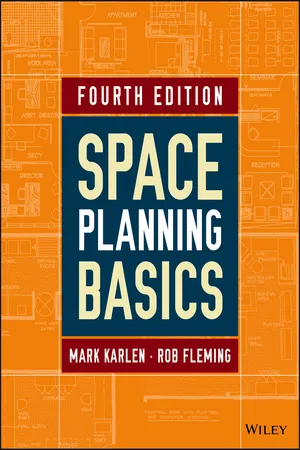
- English
- ePUB (mobile friendly)
- Available on iOS & Android
Space Planning Basics
About this book
Conquer the complexity of interior design with a logical, methodical approach
Space Planning Basics is a definitive introduction and principle resource for thousands of designers. With step-by-step methodology based on the author's several decades of design experience, this authoritative guide has become the de facto reference for an entire generation of designers. This updated fourth edition includes digitized drawings, diagrams, and matrices throughout, and newly added supplemental photographs. The text has been revised to reflect the latest developments in sustainable and universal design, including coverage of daylighting, benchmarking, LEED system standards, and green code issues. The companion website provides AutoCAD files, intrustor videos and matrices to give you a deeper real-world understanding of the design process. This book is perfect preparation for the NCIDQ exam.
Proper space planning goes way beyond sketching a preliminary floor plan. Successful implementation includes a balanced integration of code compliance, system support, and adherence to the client's functional needs. Sustainability adds a new, important layer of complexity. This book shows you how to approach space planning in a way that ensures all considerations are met, and nothing gets lost in the process.
- Adopt an organized and comprehensive planning methodology
- Work effectively with dimensionally challenging spaces
- Consider building systems, codes, lighting, acoustics, and more
- Develop advanced skills and conquer new challenges
Space planning encompasses many components and processes, making a comprehensive reference necessary for mastery of the field. Space Planning Basics is a thorough, methodical resource that gets you started on the right track, with plenty of room for creativity.
Frequently asked questions
- Essential is ideal for learners and professionals who enjoy exploring a wide range of subjects. Access the Essential Library with 800,000+ trusted titles and best-sellers across business, personal growth, and the humanities. Includes unlimited reading time and Standard Read Aloud voice.
- Complete: Perfect for advanced learners and researchers needing full, unrestricted access. Unlock 1.4M+ books across hundreds of subjects, including academic and specialized titles. The Complete Plan also includes advanced features like Premium Read Aloud and Research Assistant.
Please note we cannot support devices running on iOS 13 and Android 7 or earlier. Learn more about using the app.
Information
1
Planning Methodology
DEFINING TERMS AND INTENT
THE SYNTHESIS GAP
- Interview
- Executive level (organizational overview)
- Managerial level (departmental function)
- Operations level (process and equipment detail)
- Observe (existing or similar facilities)
- Assisted observation
- Unobtrusive observation
- Inventory of existing furniture and equipment (when it is to be reused)
- Establish architectural parameters
- Acquire complete base plan data (including mechanical and electrical services)
- Compile contextual data (architectural, historical, social)
- Research environmental and code constraints
- Complete basic site inventory (sun angles, breeze directions, and rainfall amounts)
- Organize collected data (the first-phase program)
- Place data in sequential format most useful for planning
- Summarize confirmed quantitative factors (square footage, FF+E (furniture, fixtures and equipment) count, equipment sizes, etc.)
- Record first thoughts on conceptual planning approach
- Research the unknowns
- Gather detailed information on process and equipment
- Gather case study...
Table of contents
- Cover
- Title Page
- Copyright
- Preface
- Introduction
- 1: Planning Methodology
- 2: The First Planning Steps: Bubble Diagrams and Block Plans
- 3: Small and Dimensionally Demanding Spaces
- 4: The Building Shell and Major Systems
- 5: Important Influencing Factors
- 6: Developing a Rough Floor Plan
- 7: Refining the Solution
- 8: Developing Skills beyond the Basic Level
- 9: Stair Design Basics
- Appendix A: Stair Terminology
- Appendix B: Design Programs and Building Shells
- Index
- Eula